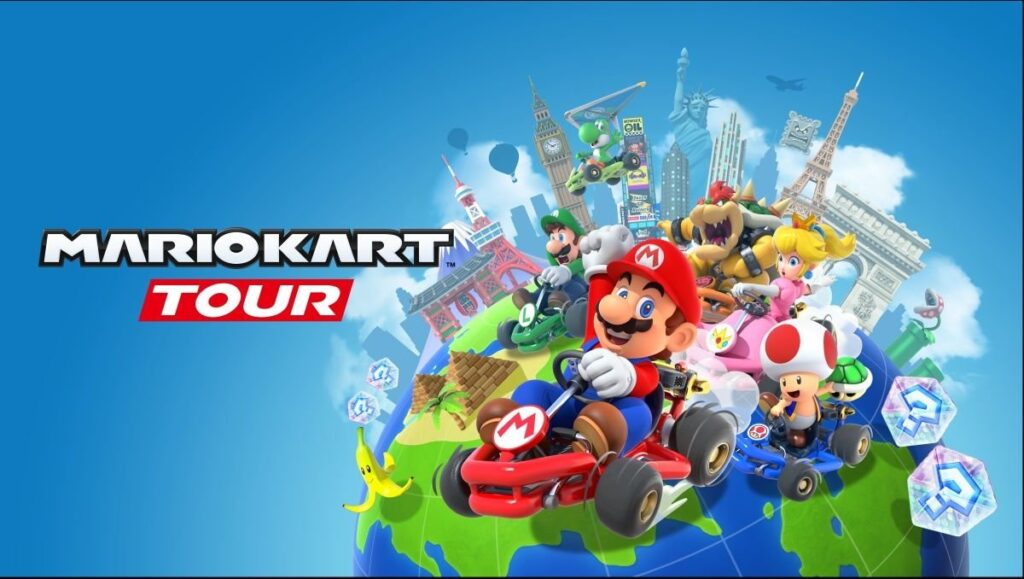
The “Mario Kart” franchise has become one of the largest recognizable game franchises in the past few decades.
In the most recent installment, “Mario Kart Tour,” Nintendo has tried to cash in on that popularity to mixed reception.
Released on Sept. 25 for iOS and Android smartphones, “Mario Kart Tour” seemingly takes the franchise back a step in terms of quality.
Following the last release, “Mario Kart 8 Deluxe” for the Nintendo Switch, “Mario Kart Tour” goes back two generations to the Nintendo 3DS to reuse assets from the seventh game in the series.
Because of the reuse of character models and tracks, the quality is clearly lower than its console predecessor.
More corners were cut because the game is on a mobile platform, by reducing the resolution of other character models the player’s opponents have chosen.
These models have lower polygon counts that are noticeable as well, because they are often not far enough out of the player’s viewpoint.
The gameplay, however, has always been the primary aspect of “Mario Kart” for players because it is easily usable to players of all ages.
Mechanics such as drifting and item usage can have a modicum of skill behind them, but for the most part, racers are on an even playing field.
This equal opportunity is completely taken away in “Mario Kart Tour” as racers have two options in navigating the race tracks: steer or drift.
Steering is just what it sounds like, manual steering across the course.
However, drifting only allows players to bunny hop and drift around courses. This can be especially irritating as you cannot adjust your trajectory to simply drive straight, instead the kart is always veering slightly to the left or right.
Veteran players may take to this change quickly as many courses are designed with very few straightaways, but for newcomers and novices, this driving mode can be hard to adjust to.
In an attempt to solve this issue for new drivers, the “Smart-Steering” feature introduced in “Mario Kart 8” can be selected. Smart-Steering assists the driver, trying to keep them as close to the center of the track as possible, while still allowing them a bit of freedom over their movements.
Players progress through different groups of four tracks, referred to as “Cups.”
Each Cup has three normal tracks and a challenge track. Each normal track may have a variation such as being driven in reverse, noted by an “R,” or having extra ramps, noted by a “T” for trick.
Depending on the position, amount of tricks and used items the player earns points which earn them Grand Stars.
After earning a set amount of Grand Stars, new cups are unlocked with occasional gift boxes.
The largest controversy surrounding the game — even before release — was the inclusion of “micro-transactions,” meaning that players would have the ability to purchase in game currency with real world money to have an advantage over other players.
The in game currency, rubies, come in bundles ranging from $1.99 to $69.99.
These rubies are then used in what players refer to as a “gacha” mechanic, otherwise known as “loot boxes.”
The downside of using the mechanic is the loot boxes are seen as a form of gambling.
Outlawing video game loot boxes as gambling has been a debate for nearly a decade.
Since 2018, the Children’s Online Privacy Protection Act began circulating to protect children who play video games from these mechanics to stop minors from gambling.
China has already incorporated measures by requiring game publishers to disclose the drop rate, or percentage chance, players would get for particular items.
The loot box system is not the only payment issue that players have with the game.
Paying a subscription fee of $4.99 per month, players can earn extra rubies and rarer kart parts by progressing in the game.
After earning a certain amount of Grand Stars, players will unlock a gift box.
Within the boxes there are one or two normal items such as coins, and the exclusive gold items — taunting those who have not payed the subscription fee with a preview of what could be earned.
Players no longer have the freedom to choose any driver or kart they want and are limited to the ones they have unlocked.
Each driver and kart is also now ranked as “Normal,” “Super” or “High-End.”
These rankings determine the amount of points that selecting each driver or kart can earn a player in a race.
The amount of base points can be increased by leveling up the driver and kart by racing, but the amount of level ups is limited per day.
Because of this limit, players that want to advance faster are left with the decision of having to wait another day or spend money on rubies to earn coins in the “Coin Rush” mode, allowing them to purchase “Upgrade Tickets” in the game’s shop.
“Mario Kart Tour” is not Nintendo’s first foray into the mobile game market, previously releasing “Animal Crossing: Pocket Camp” and “Super Mario Run” for mobile devices.
Unfortunately, “Mario Kart Tour” is the most egregious for the inclusion of micro-transactions that become necessary later on in the game.
Whereas “Super Mario Run” had a flat out purchase fee of $9.99 for access to the game’s entire line up of content, “Mario Kart Tour” has chosen to go the micro-transaction route — which is sadly more traveled by game publishers in recent years.

